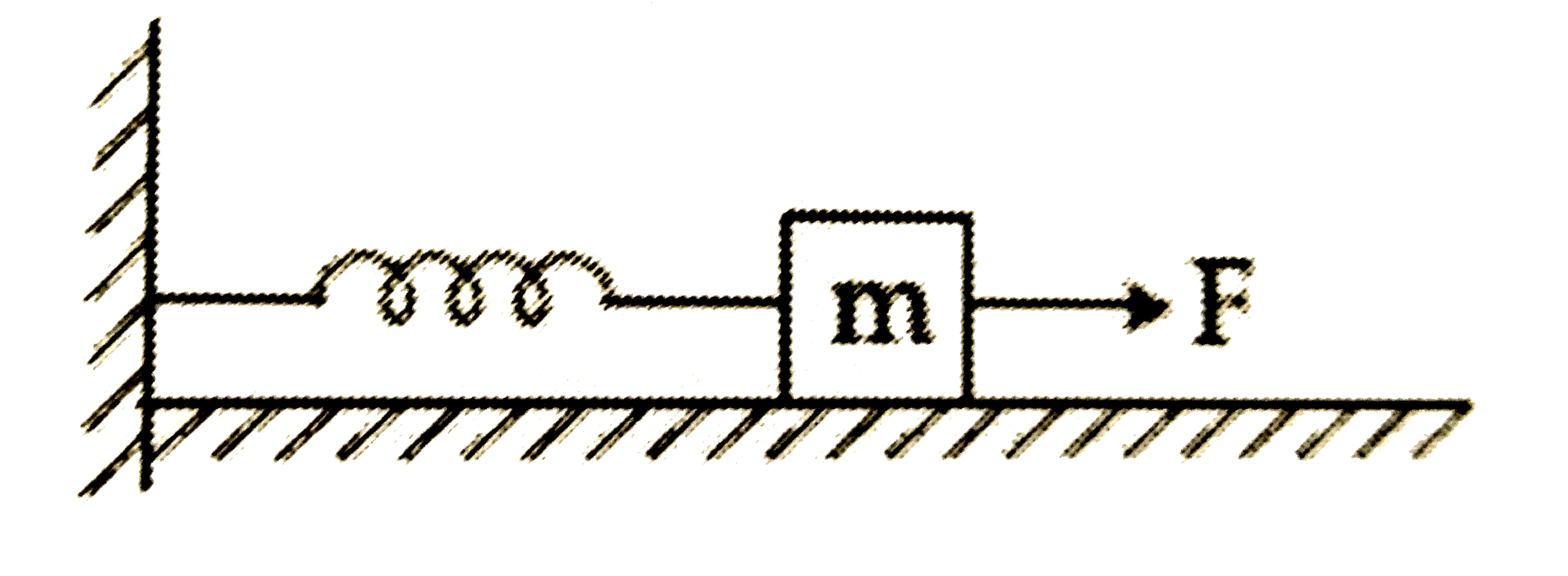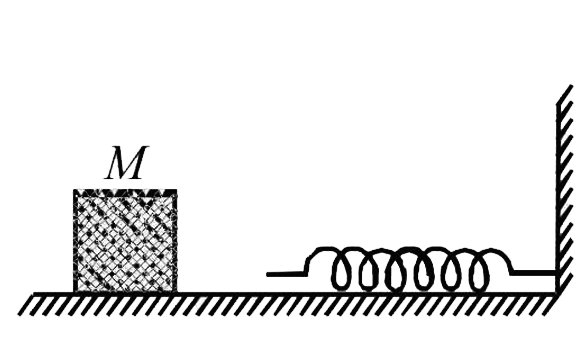A block of mass M is lying on a frictionless horizontal surface and it connected to a spring of spring constant k, whose other end is fixed to a wall, system executes simple harmonic motion of amplitude A0, when the block is passing through its equilibrium positions, an object of mass m is put on it and the two move together with a new time period T and amplitude A. Find the value of T and A in terms of given constants.
To solve the problem, we will derive the expressions for the new time period T and the new amplitude A after a mass m is placed on a block of mass M that is oscillating due to a spring with spring constant k.
Step 1: Determine the original time period T0
The time period T0 of the simple harmonic motion (SHM) for the block of mass M connected to the spring is given by the formula:
T0=2π√Mk
Step 2: Determine the new time period T
When the mass m is placed on the block, the total mass that is now oscillating becomes M+m. The new time period T can be expressed as:
T=2π√M+mk
Step 3: Relate the new time period T to the original time period T0
To express T in terms of T0, we can divide the new time period by the original time period:
TT0=2π√M+mk2π√Mk
This simplifies to:
TT0=√M+mM
Thus, we can express T as:
T=T0√M+mM
Step 4: Determine the new amplitude A
To find the new amplitude A, we will use the conservation of momentum principle. The maximum velocity V1 of the block before placing the mass m is given by:
V1=A0⋅ω0=A0⋅√kM
After placing the mass m, the maximum velocity V2 of the combined mass M+m is given by:
V2=A⋅ω=A⋅√kM+m
Using the conservation of momentum just before and just after placing the mass, we have:
M⋅V1=(M+m)⋅V2
Substituting the expressions for V1 and V2:
M⋅(A0⋅√kM)=(M+m)⋅(A⋅√kM+m)
Step 5: Simplify the equation to find A
Cancelling √k from both sides, we get:
MA0√M+m=(M+m)A√M
Rearranging gives:
A=A0⋅M√M+m(M+m)√M=A0⋅M√M(M+m)
Thus, we can express A as:
A=A0⋅√MM+m
Final Results
The new time period T and amplitude A are given by:
T=T0√M+mM
A=A0⋅√MM+m
A=A0⋅√MM+m
Topper's Solved these Questions
- OSCILLATIONS BOOK - MODERN PUBLICATIONCHAPTER - OSCILLATIONS EXERCISE - NCERT FILE (Textbook Exercises)
19 Videos
- OSCILLATIONS BOOK - MODERN PUBLICATIONCHAPTER - OSCILLATIONS EXERCISE - NCERT (Additional Exercises)
6 Videos
- OSCILLATIONS BOOK - MODERN PUBLICATIONCHAPTER - OSCILLATIONS EXERCISE - Conceptual Questions
18 Videos
- MOTION IN A STRAIGHT LINE BOOK - MODERN PUBLICATIONCHAPTER - MOTION IN A STRAIGHT LINE EXERCISE - CHAPTER PRACTICE TEST
16 Videos
- PHYSICAL WORLD BOOK - MODERN PUBLICATIONCHAPTER - PHYSICAL WORLD EXERCISE - Revision exercises (Long answer questions)
6 Videos
Similar Questions
A horizontal spring block system of mass M executes simple har monic motion.w hen the block is passingle through its equilibrium position, an object of mass m is put on it and the two move tother. Find the new amplitude and frequency of vibration.
View SolutionA horizontal spring block system of mass M executes simple haormonic motion. When the block is passing through its equilibrium position, an object of mass m is put on it and the two move together. Find the new amplitude and frequency of vibration. Given, k is the spring constant of the system.
View Solution
Knowledge Check
A horizontal spring-block system of mass 1kg executes SHM of amplitude 10 cm. When the block is passing through its equilibrium position another mass of 1kg is put on it and the two move together.
Aamplitude will remain unchangedBamplitude will become 5√2 cmCthe frequency of oscillations will remain sameDthe frequency of oscillations will decrease.A horizontal spring is connedted to a mass M. It exectues simple harmonic motion. When the mass M passes through its mean position, an object of mass m is put on it ans the two move together. The ratio of frequencies before and after will be-
A(1+mM)1/2B(1+mM)C(MM+m)1/2D(MM+m)A horizontal spring -block system of mass 2kg executes S.H.M when the block is passing through its equilibrium positiojn an object of mass 1kg is put on it the two move togather The new amplitude of vibration is (A being its initial amplitude)
A√23AB√32AC√2AD√A√2
A block of mass m, lying on a smooth horizontal surface, is attached to a spring (of negligible mass) of spring constant k. The other end of the spring is fixed, as shown in the figure. The block is initally at rest in its equilibrium position. If now the block is pulled withe a constant force F, the maximum speed of the block is :

View SolutionA block of mass m, lying on a smooth horizontal surface, is attached to a spring (of negligible mass) of spring constant k. The other end of the spring is fixed, as shown in the figure. The block is initally at rest in its equilibrium position. If now the block is pulled withe a constant force F, the maximum speed of the block is :

View SolutionA block of mass m1 resting on a frictionless horizontal surface is connected to a spring of spring constant k that is anchored in a near by wall. A block of mass m2 is placed on the top of the first block. The coefficient of static friction between the two blocks is μ Assuming that the two blocks move together as a unit, find the period of oscillation of the system and also find maximum oscillation amplitude that permits the two bodies to move as a unit.
View SolutionThe block of mass M moving on the frictionless horizontal surface collides with the spring constant k and compresses it by length L . The maximum momention of the block after collision is

View SolutionA mass m, connected to a horizontal spring performs SHM with amplitude A. While mass m, is passing through mean position, another mass m, is placed on it so that both the masses move together with amplitude A,. The ratio of
View Solution
